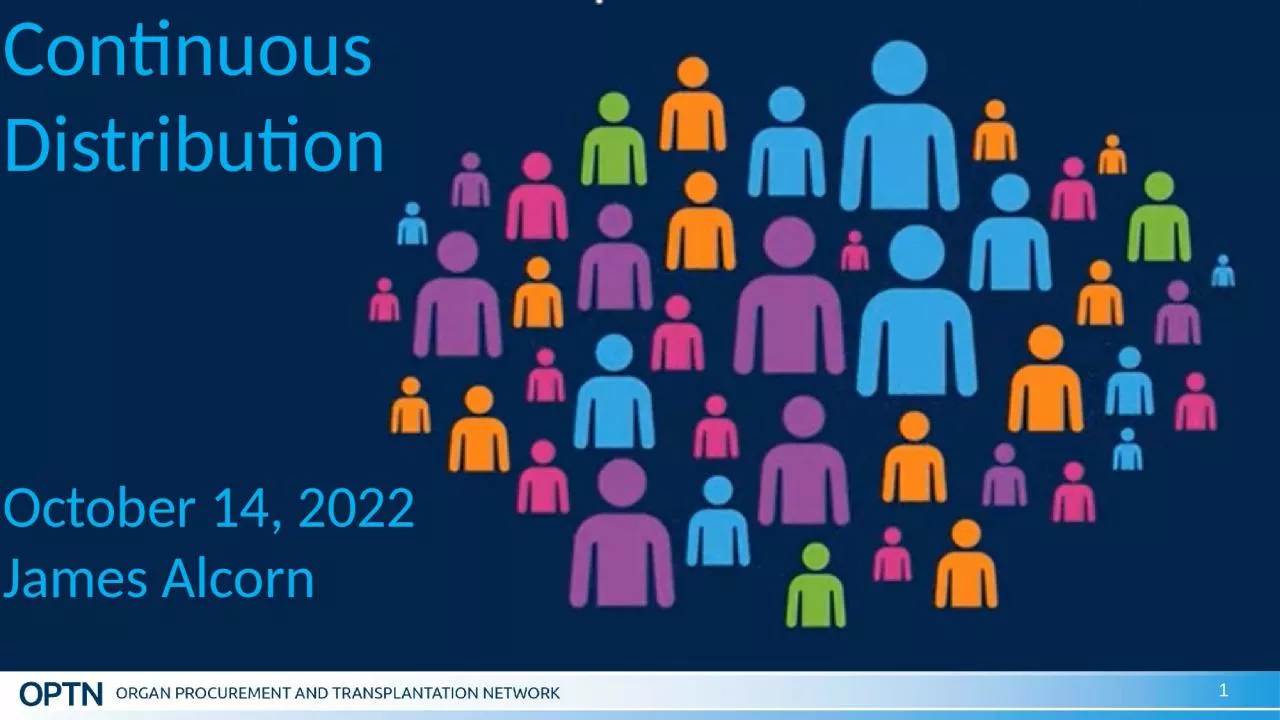

October 14 2022 James Alcorn Acknowledgement This work was supported wholly or in part by Health Resources and Services Administration HRSA contract 25020190001C The content is the responsibility of the authors alone and does not necessarily reflect the views or policies of the Departme ID: 1011409
Download Presentation The PPT/PDF document "1 Continuous Distribution" is the property of its rightful owner. Permission is granted to download and print the materials on this web site for personal, non-commercial use only, and to display it on your personal computer provided you do not modify the materials and that you retain all copyright notices contained in the materials. By downloading content from our website, you accept the terms of this agreement.
1. 1ContinuousDistributionOctober 14, 2022James Alcorn
2. AcknowledgementThis work was supported wholly or in part by Health Resources and Services Administration (HRSA) contract 250-2019-0001C. The content is the responsibility of the authors alone and does not necessarily reflect the views or policies of the Department of Health and Human Services, nor does mention of trade names, commercial products, or organizations imply endorsement by the U.S. Government.
3. BackgroundChanges in AllocationChanges in Policy DevelopmentTimelinesAgenda
4. In 2018, the Board of Directors approved a “continuous distribution” model as a framework for future policy development of organ allocationBackground4Current system: places candidates into rank-ordered classifications reviewed in sequence New framework: ranks all candidates using a composite allocation score, without categorizing into classificationsThe composite score is determined by multiple factors, called “attributes,” that are weighted against each other during the calculation
5. Key characteristicsFlexibleThe framework will apply to all organ typesMore equitableNo one factor will determine a candidate’s placement on the waiting listAgileThe framework will be more responsive and adaptable to future changes
6. Change in How we Allocate Organs6
7. The more points a candidate receives in their composite allocation score, the higher they will be on a match run for an organ offer. As seen in this generic example, Candidate A received the most amount of points, based on their particular combination of attributes.
8. 8Medical UrgencyPost-Transplant SurvivalCandidate BiologyPatient AccessPlacement EfficiencyLungPart of LASPart of LASBlood TypeCPRAHeightPrior Living DonorsPediatricsHeightProximity Efficiency Kidney Medical Urgency DefinitionHLA MatchingEPTSBlood TypeCPRAPrior Living DonorsPediatricsKidney-after-Liver Safety NetWaiting TimeProximity Efficiency Pancreas Blood TypeCPRAPrior Living DonorsPediatricsWaiting TimeProximity EfficiencyLiverMELDPELDBlood TypeCPRAPrior Living DonorsPediatricsWaiting TimeMulti-OrganProximity EfficiencyPopulation densityHeartAdult and Pediatric statusesBlood TypeCPRASizePrior Living DonorsPediatricsWaiting TimeMulti-OrganProximity Efficiency
9. 9
10. Waiting List Mortality10 Reduces overall lung waiting list mortality by more than 1/3
11. Placement Efficiency11Traveling farthest for the most urgent candidatesMuch smaller changes in distances for less urgent candidates Continuous Distribution = Smarter Distribution
12. Change in How we Develop Policy12
13. Community input is being used through each phase of development to inform evidence-based rules for the new system. Here are the steps we’ll take:Process to move each organ type to continuous distribution13
14. What is a rating scale?14Candidate ACandidate B
15. How is the OPTN is using AHP?
16. 16
17. Rank correlation = 0.933Kendall’s Tau = 0.803Approximating an adult donor match run
18. Stakeholder feedback is key to AHP123Criteria DefiningEstablishing Criteria ImpactFinal Criteria Weights
19. Priorities Rankings1910817135781
20. Cross-Organ AHP Results20
21.
22.
23. Post-Transplant Survival23
24.
25. Ted Papalexopoulos, Dimitris Bertsimas, Nikos TrichakisMIT Operations Research Center3/25/21OPTN Lung Committee MeetingContinuous Distribution: Tradeoffs through Optimization
26. Utility vs. Efficiency Tradeoff Curve*Proximity weight does not apply to “Current” policy.26
27. At what prox. weight does marginal mortality gain diminish?*Proximity weight does not apply to “Current” policy.27Range around 10% seems to be a “sweet spot”
28. Pediatric TX rate stabilizes above 15% pediatric weight.* Sensitivity analysis performed by fixing pediatric weight and randomly weighting remaining factors.28
29. 201920202021202220232024202520262027LungKiPALiver and IntestineHeartVCAOverall Schedule29
30. Progress To Date30
31. Same 5 goalsAdditive scoreAttributes: Prior Living Donor, CPRA, PediatricsReview BoardsEvery organ has a review boardAllows peers to review unique casesCross Organ Similarities31
32. Resourceshttps://optn.transplant.hrsa.gov/policies-bylaws/a-closer-look/continuous-distribution/
33. 33
34. Additional Slides, if needed34
35. Currently, kidney allocation and candidate prioritization differs depending on the donor kidney’s KDPIWeight modifiers can replicate this, and mathematically modify the relative importance of each attribute based on KDPIWeight Modifiers35
36. AttributeKDPI 0-20%KDPI 21-34%KDPI 35-85%KDPI 86-100%Medical Urgency 1111HLA Matching1111EPTS/KDPI1111Blood Type1111CPRA1111Prior Living Donor1110Pediatrics1110KAL Safety Net0111Qualifying Time1111Proximity Efficiency1114Kidney Weight Modifiers36*Includes pediatric priority for KDPI 35-85% for pediatric donors